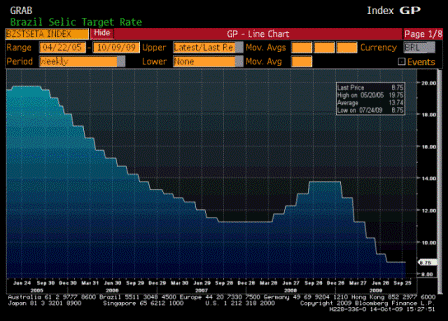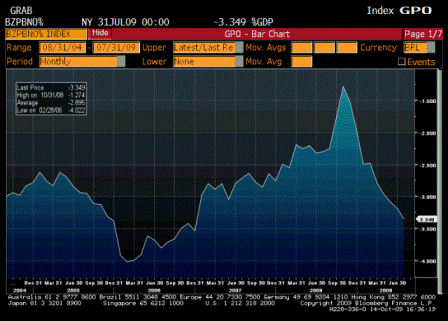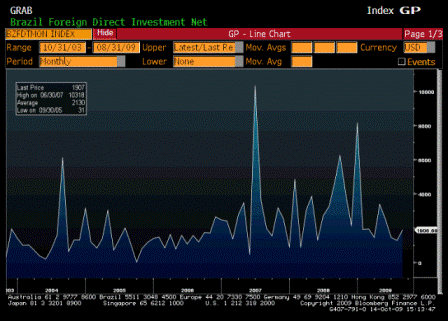[Skip to the end]
Like depository institutions in the United States, foreign banks with large dollar-funding needs have also experienced powerful liquidity pressures over the course of the crisis. This unmet demand from foreign institutions for dollars was spilling over into U.S. funding markets, including the federal funds market, leading to increased volatility and liquidity concerns. As part of its program to stabilize short-term dollar-funding markets, the Federal Reserve worked with foreign central banks–14 in all–to establish what are known as reciprocal currency arrangements, or liquidity swap lines. In exchange for foreign currency, the Federal Reserve provides dollars to foreign central banks that they, in turn, lend to financial institutions in their jurisdictions. This lending by foreign central banks has been helpful in reducing spreads and volatility in a number of dollar-funding markets and in other closely related markets, like the foreign exchange swap market. Once again, the Federal Reserve’s credit risk is minimal, as the foreign central bank is the Federal Reserve’s counterparty and is responsible for repayment, rather than the institutions that ultimately receive the funds; in addition, as I noted, the Federal Reserve receives foreign currency from its central bank partner of equal value to the dollars swapped.
Looks like they still fail to recognize these dollar loans are functionally unsecured.
The principal goals of our recent security purchases are to lower the cost and improve the availability of credit for households and businesses. As best we can tell, the programs appear to be having their intended effect. Most notably, 30-year fixed mortgage rates, which responded very little to our cuts in the target federal funds rate, have declined about 1-1/2 percentage points since we first announced MBS purchases in November, helping to support the housing market.
Correct on this count. Treasury purchases are about interest rates and not quantity.
Currency and bank reserves together are known as the monetary base; as reserves have grown, therefore, the monetary base has grown as well. However, because banks are reluctant to lend in current economic and financial circumstances, growth in broader measures of money has not picked up by anything remotely like the growth in the base. For example, M2, which comprises currency, checking accounts, savings deposits, small time deposits, and retail money fund shares, is estimated to have been roughly flat over the past six months.
Correct here as well, where he seems to recognize the ‘base’ is not causal. Lending is demand determined within a bank’s lending criteria.
The idea behind quantitative easing is to provide banks with substantial excess liquidity in the hope that they will choose to use some part of that liquidity to make loans or buy other assets.
Here, however, there is an implied direction of causation from excess reserves to lending. This is a very different presumed transmission mechanism than the interest rate channel previously described.
Such purchases should in principle both raise asset prices and increase the growth of broad measures of money, which may in turn induce households and businesses to buy nonmoney assets or to spend more on goods and services.
Raising asset prices is another way to say lowering interest rates, which is the same interest rate channel previously described.
In a quantitative-easing regime, the quantity of central bank liabilities (or the quantity of bank reserves, which should vary closely with total liabilities) is sufficient to describe the degree of policy accommodation.
The degree of policy accommodation is the extent to which interest rates are lower than without that accommodation, if one is referring to the interest rate channel, which at least does exist.
The quantity of central bank liabilities would measure the effect of the additional quantity of reserves, which has no transmission mechanism per se to lending or anything else, apart from interest rates.
However, the chairman is only defining his terms, and he’s free to define ‘accommodation’ as he does, though I would suggest that definition is purely academic and of no further analytic purpose.
Although the Federal Reserve’s approach also entails substantial increases in bank liquidity, it is motivated less by the desire to increase the liabilities of the Federal Reserve than by the need to address dysfunction in specific credit markets through the types of programs I have discussed. For lack of a better term, I have called this approach “credit easing.”11 In a credit-easing regime, policies are tied more closely to the asset side of the balance sheet than the liability side, and the effectiveness of policy support is measured by indicators of market functioning, such as interest rate spreads, volatility, and market liquidity. In particular, the Federal Reserve has not attempted to achieve a smooth growth path for the size of its balance sheet, a common feature of the quantitative-easing approach.
Here he goes back to his interest rate transmission mechanism which does exist. But the implication is still there that the quantity of reserves does matter to some unspecified degree.
As we just saw in slide 6, banks currently hold large amounts of excess reserves at the Federal Reserve. As the economy recovers, banks could find it profitable to be more aggressive in lending out their reserves, which in turn would produce faster growth in broader money and credit measures and, ultimately, lead to inflation pressures.
When he turns to the ‘exit strategy’ it all goes bad again. Banks don’t ‘lend out their reserves.’ in fact, lending does not diminish the total reserves in the banking system. Loans ‘create’ their own deposits as a matter of accounting. If the banks made $2 trillion in loans tomorrow total reserves would remain at $2 trillion, until the Fed acted to reduce its portfolio.
Yes, lending can ‘ultimately lead to inflation pressures’ but reserve positions are not constraints on bank lending. Lending is restricted by capital and by lending standards.
Under a gold standard loans are constrained by reserves. Perhaps that notion has been somehow carried over to this analysis of our non convertible currency regime?
As such, when the time comes to tighten monetary policy, we must either substantially reduce excess reserve balances or, if they remain, neutralize their potential effects on broader measures of money and credit and thus on aggregate demand and inflation.
Again, altering reserve balances will not alter lending practices. The Fed’s tool is interest rates, not reserve quantities.
Although, in principle, the ability to pay interest on reserves should be sufficient to allow the Federal Reserve to raise interest rates and control money growth, this approach is likely to be more effective if combined with steps to reduce excess reserves. I will mention three options for achieving such an outcome.
More of the same confusion. Yes, paying interest will be sufficient to raise rates. However a different concept is introduced, raising interest rates to control ‘money growth’ rather than, as previously mentioned, raising rates to attempt to reduce aggregate demand. Last I read and observed the Fed has long abandoned the notion of attempting control ‘money growth’ as a means of controlling aggregate demand. The ‘modern’ approach to monetarism that prescribes interest rate manipulation to control aggregate demand does not presume the transmission mechanism works through ‘money supply’ growth, but instead through other channels.
First, the Federal Reserve could drain bank reserves and reduce the excess liquidity at other institutions by arranging large-scale reverse repurchase agreements (reverse repos) with financial market participants, including banks, the GSEs, and other institutions.
Reverse repos are functionally nothing more than another way to pay interest on reserves.
Second, using the authority the Congress gave us to pay interest on banks’ balances at the Federal Reserve, we can offer term deposits to banks, roughly analogous to the certificates of deposit that banks offer to their customers. Bank funds held in term deposits at the Federal Reserve would not be available to be supplied to the federal funds market.
This is also just another way to pay interest on reserves, this time for a term longer than one day.
Third, the Federal Reserve could reduce reserves by selling a portion of its holdings of long-term securities in the open market.
Back to the confusion. The purpose of the purchase of long term securities was to lower long term rates and thereby help the real economy. Selling those securities does the opposite- it increases long term rates, and will presumably slow things down in the real economy.
However, below, he seems to miss that point, and returns to assigning significance to ‘money supply’ measures.
Each of these policy options would help to raise short-term interest rates and limit the growth of broad measures of money and credit, thereby tightening monetary policy.
[top]




